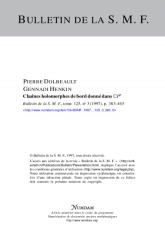Chaînes holomorphes de bord donné dans $\mathbb {CP}^n$

- Consulter un extrait
- Année : 1997
- Fascicule : 3
- Tome : 125
- Format : Électronique
- Langue de l'ouvrage :
Français - Class. Math. : 32~C~30, 49~Q~15
- Pages : 383-445
- DOI : 10.24033/bsmf.2312
Dans l'espace projectif $\mathbb {CP}^n$, ou plus généralement, dans un domaine linéairement $q$-concave $X$ de $\mathbb {CP}^n$, on considère le problème suivant : trouver une $p$-chaîne holomorphe dans $X$, de bord une sous-variété $M$ donnée de $X$, fermée, orientée, de dimension $(2p-1)$. On utilise les sous-espaces projectifs $P$ de dimension $n-p+1$ contenus dans $X$. Théorème I. — Les deux conditions suivantes sont équivalentes : (i) $M$ est le bord d'une $p$-chaîne holomorphe de $X$, de masse localement finie ; (ii) $M$ est maximalement complexe, de volume localement fini et, pour tout $P$ contenu dans $X$ et assez voisin d'un sous-espace donné, $M\cap P$ est une courbe de $P$, bord d'une 1-chaîne holomorphe de masse finie. Le théorème I se déduit du théorème II donnant une condition, généralisant la condition des moments d'Harvey-Lawson sur $M$, pour que $M$ soit le bord d'une chaîne holomorphe, et aussi d'un théorème de compacité du type de Sachs-Uhlenbeck (1981). Le théorème II généralise le résultat obtenu en 1993 pour $p=1$. Des corollaires redonnent les théorèmes connus dans $\mathbb {C}^n$ et $\mathbb {CP}^n\smallsetminus \mathbb {CP}^{n-r}$ dus à Wermer, Harvey, Lawson, Chirka et d'autres. On s'est borné au cas où $M$ est de e $C^2$, éventuellement avec des singularités négligeables.

